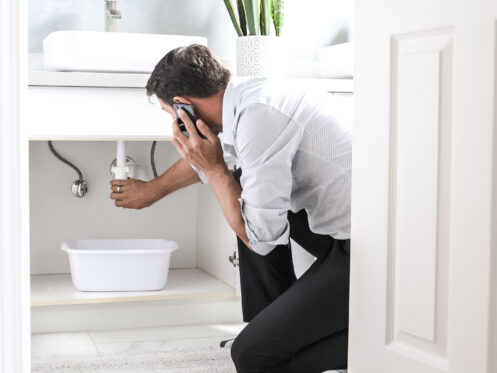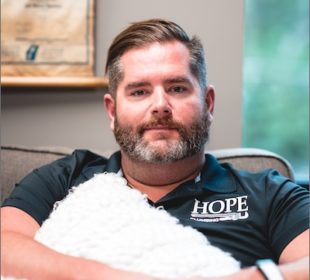Plumbing emergencies often arise out of nowhere, catching you completely off guard. This doesn’t mean you need to freak out, though. Instead, you should remain calm and take certain steps to deal with the problem.
Immediate Actions to Take
Regardless of the nature of your plumbing emergency, there are critical steps you must take without delay to prevent the situation from getting worse. To begin, shut off the water main by finding and turning off the main water valve. To isolate the problem, switch off the valve that controls that particular fixture. If the problem involves the water heater, go ahead and turn it off. Last but not least, stay level-headed and, if the issue persists, contact a licensed plumber.
Essential Tools and Supplies
You should always have essential tools and supplies on hand in case of a plumbing emergency. To secure loose connections, an adjustable wrench comes in handy. When fixing clogged toilets or drains, a plunger is a must-have tool. Duct tape and pipe adhesive are useful for sealing leaks temporarily. If there is a leak or spill, a bucket and some towels can help catch the water and reduce water damage. Having a flashlight also makes it easier to see in low light or in difficult-to-access places. And lastly, save the number of a dependable emergency plumber on your phone.
Dealing With Burst Pipes
Turning off the main water valve is the first line of defense against flooding when dealing with burst pipes. To release any trapped water and lower the pressure in the pipes, it’s best to turn on every faucet. You can mop up the mess with towels or buckets to further prevent water damage. If the pipe is accessible, you can use pipe tape or a combination of rubber and a clamp to temporarily fix a burst pipe until a plumber can implement a permanent solution.
Managing Clogged Drains
A level head and some basic equipment are sometimes all you need to handle clogged drains successfully. First, you should never use chemical drain cleaners; doing so will only destroy your pipes. Instead, you should try to remove the obstruction with a plunger while applying constant, strong pressure to ensure a tight seal. To unclog drains that are deeper in the pipe, a plumber may need to use an auger or a drain snake.
Addressing Water Heater Issues
First things first: disconnect the power from the water heater. To turn off a gas heater, turn off the gas valve, and to turn off an electric heater, turn off the circuit breaker. Tighten any loose connections, and look for visible signs of leakage all around the unit. In the event of a major leak, turning off the water supply to the heater is the best way to prevent further damage. Don’t attempt to work on the water heater yourself. This can be very dangerous. Instead, bring in a plumber.
Handling Sewage Backup
The first step in preventing further sewage from entering your residence is to cut off the water supply to the home. You might try using a plunger to unclog a single drain if the blockage and backup are small. For major backups, however, it’s imperative that you contact a licensed plumber without delay. They have the know-how and tools to deal with the problem safely. While you wait, open windows to allow fresh air in, and if necessary, use protective gear before going into the affected area.
Coping With Frozen Pipes
Turn off the water main to minimize any possible leaks. To release pressure, open any faucets connected to the frozen pipe. Next, contact a plumber. The plumber will look for leaks or breaks in the pipe while using specialized equipment to safely defrost it. They may also suggest insulating the pipe.
Sump Pump Failure
Basements are especially vulnerable to water damage from a broken sump pump. Outages of electricity, broken machinery or blocked discharge pipes are common causes of this issue. Keep cool and examine the power source. If needed, reset the circuit breaker. Try turning the power off and then back on again to make sure the pump works as it should. Find anything in the sump pit that might be obstructing the pump and remove it if necessary. Make sure the float switch can move freely and turn on the pump. If the sump pump is still not functioning correctly, get in touch with a plumber.
Running Toilets
Leaving the toilet running all the time is a certain way to raise your water bill and waste water. This problem is commonly caused by faulty flappers, fill valves, or flush valve assemblies. Take off the tank cover and look inside to see what the issue might be. Check the flapper for damage or wear, and replace it if necessary to ensure tight sealing. Make sure the flapper’s chain isn’t too long or tangled. If the water level is too high, you can either replace the fill valve or adjust the float arm. You also need to retighten any connections that are dangling around the flush valve. If these troubleshooting steps don’t fix the problem, you should call a plumber.
Low Water Pressure
Low water pressure is a noticeable sign of plumbing problems. Some common causes of this include aerator blockages, leaks, or issues with the main water line. Begin by removing any mineral buildup from the aerators of the faucets and showerheads. Expert assistance may be necessary if the problem continues, since it might indicate a problem with the main water supply or pressure regulator. Experts can find and mend any obvious leaks in pipes and fittings. They can also measure the water pressure and advise you on whether to install a pressure booster.
Garbage Disposal Issues
Problems with a garbage disposal, like blockages, jams, or leaks, can interrupt your regular cooking and cleaning schedule. Before you start trying to fix the problem, make sure the disposal is off and disconnected. Check the disposal for any obvious obstacles by shining a light on it. To manually spin the blades and release a jam, you can use a disposal wrench or a wooden spoon. Because of the risk of disposal damage, you should stay away from chemical drain cleaners. Check all connections and tighten any screws causing the disposal to leak. You can try pressing the reset button on the disposal’s base if it still won’t turn on. A plumber can check for electrical faults and even replace the device if the problem persists.
Knowing When to Call a Professional
Seek professional assistance if need leak detection, major blockages, problems with your water heater, or any scenario involving sewage. It’s also best to call a plumber if you encounter a plumbing issue that is beyond your DIY capabilities or one that poses a significant danger of water damage.
Any time you experience a plumbing emergency in Indianapolis, IN, Hope Plumbing is here to help. In addition to emergency plumbing services, we also offer gas line inspections and water softener installations. To arrange an emergency repair, contact us as soon as possible. Ask us about our maintenance membership!

